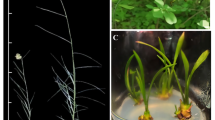Abstract
Clementine (Citrus nobilisxCitrus aurantium amara pumila) is a chloroembryophyte with green quiescent embryos and hypogeal germination. The cotyledonal chloroplasts have been studied during germination in the dark and under two different irradiances 120 and 240 μmol·m-2·s-1 throughout a period of three weeks. The plastids of the outer adaxial and inner regions develop differently. In the light, the former differentiate a photosynthetically active thylakoid system with an ultrastructural organization and a polypeptide composition resembling that of leaf chloroplasts. The “inner” chloroplasts maintain an organization reminiscent of chloroplasts of the quiescent embryo and never get beyond the photosynthesis/respiration compensation point; their differentiation pattern appears essentially the same under the two different irradiances. These observations and the germination in the dark indicate that the above differentiation is not strictly photodependent. The greening ability of the cotyledons provides, on occasion, an additional photosynthetic supply to this plant.
Similar content being viewed by others
Abbreviations
- Chl a-P:
-
chlorophyll a-protein-complex
- CF1:
-
coupling factor complex
- SDS-PAGE:
-
sodium dodecyl sulfate-polyacrylamide gel electrophoresis
References
Allred, D.R., Staehelin, L.A. (1985) Lateral distribution of the cytochrome b6/f and coupling factor ATP synthetase complexes of chloroplast thylakoid membranes. Plant Physiol. 78, 199–202
Andersson, B., Sundby, C., Åkerlund, H.E., Albertsson, P.Å. (1985) Inside-out thylakoid vesicles. An important tool for the characterization of thylakoid membranes. Physiol. Plant. 65, 322–330
Avery, G.S. (1933) Structure and development of the tobacco leaf. Am. J. Bot. 20, 565–592
Casadoro, G., Mariani Colombo, P., Rascio, N. (1980) Plastids in the quiescent embryo and young seedlings of the chloroembryophyte Citrus nobilisxCitrus aurantium amara pumila. Ann. Bot. 45, 415–418
Casadoro, G., Rascio, N. (1977) Relationship between plastids with a membrane-bound body and cell differentiation gradients in belladonna. Caryologia 30, 189–198
Casadoro, G., Rascio, N. (1979) Patterns of thylakoid system formation. J. Ultrastruct. Res. 69, 307–315
Chua, N.H., Bennoun, P. (1975) Thylakoid membrane polypeptides of Chlamydomonas reinhardtii: wild type and mutant strains deficient in photosystem II reaction center. Proc. Natl. Acad. Sci. USA 72, 2175–2179
Foster, A.S. (1936) Leaf differentiation in Angiosperm. Bot. Rev. 2, 349–372
Inskeep, W.P., Bloom, P.R. (1985) Extinction coefficients of chlorophyll a and b in N,N-dimethylformamide and 80% acetone. Plant Physiol. 77, 483–485
Ishii, R., Yamagishi, T.Y., Murata, Y. (1977) On a method for measuring photosynthesis and respiration of leaf slices with an oxygen electrode. Jap. J. Crop Sci. 46, 53–57
Kirk, J.T.O., Tilney-Bassett, R.A.E. (1978) The plastids. Their chemistry, structure, growth and inheritance. Elsevier/North-Holland biomedical Press, Amsterdam New York Oxford
Machold, O., Simpson, D.J., Møller, B.L. (1979) Chlorophyll-proteins of thylakoids from wild-type and mutants of barley (Hordeum vulgare L.). Carlsberg Res. Commun. 44, 235–254
Marin, L., Dengler, R.E. (1972) Granal plastids in the cotyledons of the dry embryo of Kochia childsii. Can. J. Bot. 50, 2049–2052
Moran, R., Porath, D. (1980) Chlorophyll determination in intact tissues using N,N-dimethylformamide. Plant Physiol. 65, 478–479
Orsenigo, M. (1964) Modificazioni strutturali dei plastidi in semi germinanti. Osservazioni sui cotiledoni di Citrus nobilisxC. aurantium amara pumila e sull'endosperma di Ricinus communis. G. Bot. Ital. 71, 43–56
Palanisamy, K., Vivekanandan, M. (1985) Formation of chloroplast pigments in the chloroembryo of Dolichos lablab L. Photosynthetica 19, 172–176
Periasamy, K., Vivekanandan, M. (1981) Photosynthesis in the chloroembryo of Cyamopsis tetragonaloba Taub. Ann. Bot. 47, 793–797
Pinfield, N.J., Stobart, A.K., Crawford, R.M., Beckett, A. (1973) Carbon assimilation by sycamore cotyledons during early seedling development. J. Exp. Bot. 24, 1203–1207
Rascio, N., Casadoro, G. (1985) Indagini sui plastidi di semi con cotiledoni ipogei verdi: pistacchio (Pistacia vera L.). G. Bot. Ital. 119, Suppl. 2, 117
Rascio, N., Casadoro, G., di Chio, L. (1979) Etioplast-chloroplast transformation in sunflower cotyledons. Protoplasma 100, 45–52
Rascio, N., Mariani Colombo, P., Orsenigo, M. (1980) The ultrastructural development of plastids in leaves of maize plants exposed to continuous illumination. Protoplasma 102, 131–139
Reuther, W., Batchelor, L.D., Webber, H.J. (1968) The citrus industry, vol. II, rev. edn., University of California, Riverside, USA
Ryczkowski, M., Szezczyk, E. (1973) Photosynthesis in the developing embryo of Haemanthus katharinae Bak. (monocotyledonous plant). Bull. Acad. Pol. Sci. Ser. Sci. Biol. 21, 269
Ryczkowski, M., Szewczyk, E. (1975) Further research on the photosynthesis in the green developing embryos (dicotyledonous plants). Z. Pflanzenphysiol. 75, 175–180
Staehelin, L.A., DeWit, M. (1984) Correlation of structure and function of chloroplast membranes at the supramolecular level. J. Cell. Biochem. 24, 261–269
Szewczyk, E. (1974) Photosynthesis in the developing embryo of Crambe tatarica Pall. (dicotyledonous plant). Bull. Acad. Pol. Sci. Ser. Sci. Biol. 22, 53
Terashima, I., Inoue, Y. (1985a) Palisade tissue chloroplasts and spongy tissue chloroplasts in spinach: biochemical and ultrastructural differences. Plant Cell Physiol. 26, 63–75
Terashima, I., Inoue, Y. (1985b) Vertical gradient in photosynthetic properties of spinach chloroplasts depend on intraleaf light environment. Plant Cell Physiol. 26, 781–785
Yakovlev, M.S., Zhukova, G.Ya. (1980) Chlorophyll in embryos of Angiosperm seeds. A review. Bot. Notiser 133, 323–336
Whatley, J.M., Price, D.N. (1983) Do lemon cotyledons green in the dark? New Phytol. 94, 19–27
Zhukova, G.Ya. (1981) Embryogenesis of Angiosperms: ultrastructural transformation of plastids. Acta Soc. Bot. Pol. 50, 303–306
Author information
Authors and Affiliations
Rights and permissions
About this article
Cite this article
Casadoro, G., Rascio, N. Cotyledonal chloroplasts in the hypogeal seeds of clementine. Planta 170, 300–307 (1987). https://doi.org/10.1007/BF00395020
Received:
Accepted:
Issue Date:
DOI: https://doi.org/10.1007/BF00395020




